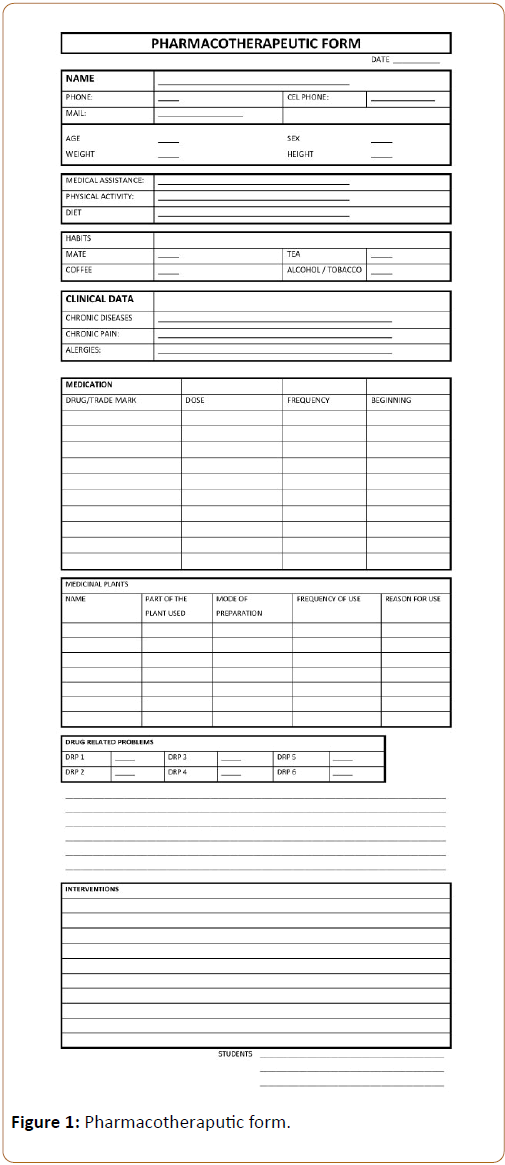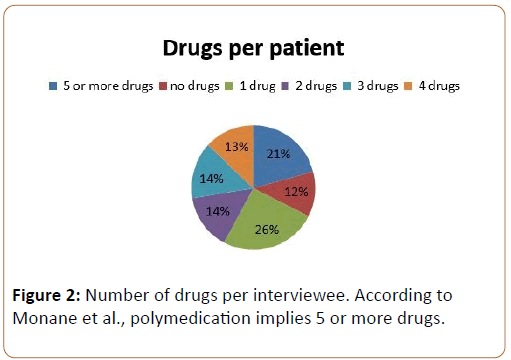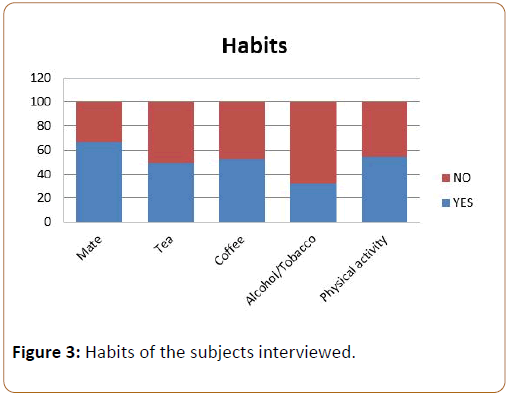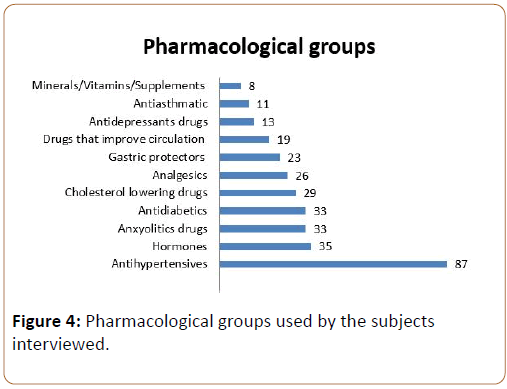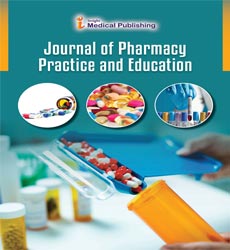Extension Activities of a Uruguayan University in the Context of Pharmaceutical Care Education in the Community
Cecilia Maldonado*, Marta Vázquez, Natalia Guevara, María E Couture, Faustina Furtado, Valerie Castillo, Camila Moreira, Florencia Oricchio, Florencia Picardo, Delfina Quiñones, Matías E Rodríguez, Federico Rosano, Gonzalo Scalese, Alejandra Schiavo, Diego Umpiérrez and Martín Umpiérrez
Pharmaceutical Sciences Department, Faculty of Chemistry, UdelaR, General Flores 2124, Montevideo Uruguay
- *Corresponding Author:
- Cecilia Maldonado
Pharmaceutical Sciences Department, Faculty of Chemistry, UdelaR. General Flores 2124, Montevideo Uruguay
Tel: 59824875001
E-mail: cmaldonado@fq.edu.uy
Received date: January 14, 2019; Accepted date: January 28, 2019; Published date: February 04, 2019
Citation:Maldonado C, Vázquezv M, Guevara N, Couture ME, Furtado F, et al. (2019) Extension Activities of a Uruguayan University in the Context of Pharmaceutical Care Education in the Community. ͘J Pharma Prac Edu Vol.2 No.1:1.
Copyright: © 2019 Maldonado C, et al. This is an open-access article distributed under the terms of the Creative Commons Attribution License, which permits unrestricted use, distribution, and reproduction in any medium, provided the original author and source are credited.
Abstract
Objective: To promote pharmacist's role in the rational use of drugs and medicinal plants. To engage students in activities related to patients and patients' care and needs, involving them in critical analysis of the data collected.
Methods and findings: a pharmaceutical care tent was put up on a public area of the Faculty of Chemistry during Heritage Day. Pharmaceutical care students carried out semi-structured surveys to passers-by, collecting information on their pharmacotherapy, and the consumption of medicinal plants, handing out information leaflets, as well. A research study was carried out from the data collected. One hundred and forty-four people (95 women and 49 men), aged between 12 and 89 years were interviewed. Forty-four percent were elderly (65 years of age or older), 21% of the total were polymedicated and 51% consumed one or more medicinal plants. Antihypertensives were the most used drugs. A 16% of the elderly presented at least one STOPP criterion and 14% a START.
Conclusions: The experience was well-accepted by the public and students felt confident in their role as future members of the health care team. Once again, the need for responsible health education of the population was demonstrated.
Keywords
University extension activities; Pharmaceuticalcare; Health care education
Abbreviations
MP: Medicinal plants; NSAIDs: Non-Steroidal Anti-inflammatory Drugs; PPI: Proton Pump Inhibitors; START Criteria: Screening Tool to Alert doctors to Right Treatment; STOPP Criteria: Screening Tool for Older Person’s Prescription
Introduction
In Uruguay the concept of University lays on three main pillars: Education, Research and Extension Activities. This fact allows the institution to maintain its autonomy and the formation of human resources which are then brought back to society with the added value of knowledge.
Extension activities entail the relationship between professors and students with different actors in society promoting that the knowledge and expertise acquired within the Institution may benefit the whole population.
Heritage Day is annually celebrated in October, promoted by the Ministry of Education and Culture. Governmental buildings, museums, churches, embassies, and others open their doors to share and promote national values with all citizens. The Faculty of Chemistry has embraced this date to share different activities with the community. Pharmacists' role in health care is still controversial in many developing countries including South American ones [1-3]. During the past years, little attention was paid to drugs effects, drug related problems and adverse drug reactions. As a consequence of this, in our setting most pharmacists were not committed to health promotion. Nowadays, however, with the concepts of clinical pharmacy and pharmaceutical care, pharmacists have slowly changed that paradigm and become responsible for how medicines are used changing the focus from pharmaceutical products to patients who consume medicines and need their positive effects in health but may also face their negative consequences. This is the result of a change in the mindset specially promoted within the University, with the incorporation in the curricula of different subjects during the career more related to patients' care. Therefore, the diffusion of the knowledge and expertise these future professionals may exert has to be divulged in the community.
Pharmaceutical care and/or pharmaceutical follow-up are activities that have patients as their focus with all the professionals assuring that patients´ pharmacotherapeutics needs are satisfied. This implies that all health problems that need a medicine have been identified and treated, that medicines are effective (indication and dose are adequate), safe (no adverse drugs reactions are reported by the patient) and adherence is appropriate [4-8].
An extension university activity was organized with professors, students and young pharmacists, not only to promote pharmacists' role in the rational use of drugs and medicinal plants in Uruguay, but also to foster activities related to patients and patients' care and needs and the critical analysis of the data collected.
Method
Last Heritage Day a Pharmaceutical Care Tent was put up on a public area of the Faculty of Chemistry so as to show the community the skills of pharmacists in health care promotion, in the understanding that when pharmaceutical products are involved, a pharmacist is fundamental. Advanced pharmacy students and young pharmacists were convoked to participate together with professors to provide passers-by with information about rational use of medicines, the use of medicinal plants, etc. Short structured interviews were performed to the passers-by according to the form showed in Figure 1. Information on pathologies, medication, habits that may impact on pharmacotherapeutic treatments (alcohol, and medicinal plants consumption among others) were consigned. Leaflets with information on medicinal plants, the correct use of proton-pump inhibitors (PPls), diabetes and hypertension, previously prepared by students, were handed-out.
Students then performed a study of the data collected, assessing polymedication, drug related problems, drug-drug interactions, drug-medicinal plants interactions. The criteria adopted for polymedication was the one of Monane et al [9]. For subjects 65 years or older, STOPP-START criteria and Anticholinergic Burden Calculator were used for information analysis [10,11]. STOPP-START criteria is a validated methodology for detecting potentially inappropriate medication in the elderly. Having a high anticholinergic burden has a strong impact on elderly as well, causing from cardiovascular to central nervous system problems. The mentioned tool is a simple way to measure how each medicine impacts on the anticholinergic burden, providing relevant information for therapeutic management.
Result and Discussion
A total of 144 forms were filled, 95 of the interviewed were women (66%), age range was 12-89 years, with older adults (over 65 years of age) comprising 44% of the total (63 passersby). Twenty-one percent of the interviewees were polymedicated (5 drugs or more on chronic treatment according to Monane), as shown in Figure 2, of those 18 subjects (60%) were elderly. Polymedication is a multicausal phenomenon and rises with age leading to higher morbidity especially in fragile patients [12-16].
Regarding habits, two thirds of the subjects consumed mate (a local caffeine-rich infused drink), 50% took tea and/or coffee frequently and a third took alcohol, drugs of abuse or smoke tobacco. Half of the interviewees exercised regularly, (Figure 3). The high consumption of tea, mate and coffee may lead to anxiety, gastric lesions and cardiovascular problems among others. These habits may be connected to the high consumption of gastric protection medicines and benzodiazepines which will be discussed later.
The most prevalent pathologies of the studied population were hypertension (40%), diabetes mellitus (15%), hypothyroidism (11%) and hypercholesterolemia (10%). These data perfectly correlate with the pharmacological groups more frequently prescribed, antihypertensives, antidiabetics, thyroid hormones and cholesterol lowering medicines in Figure 4.
Non-communicable diseases (cardiovascular and respiratory diseases, cancer, diabetes) determine almost 7 over 10 registered deaths in Uruguay, rising as the main causes of death in the country. A high percentage of these diseases and health problems can be prevented or their evolution may be slowed down through health promotion interventions.
In 2013, the Uruguayan Health Ministry carried out the Second Survey on Risk Factors. [17]. For the whole population of the country (15 to 64 years) the prevalence of hypertension is approximately 3 out of 10. Among adults, the prevalence is higher, reaching more than a third of the population aged 25 to 64 years. In comparison to 2006, this indicator has registered a significant increase of 6 percentage points (30.4% in 2006 to 36.6% in 2013). As a result, hypertension is a major health problem in Uruguayan population. More than 20% of the people between 25 and 64 years of age present high cholesterol levels in 2013 and diabetes prevalence is about 6% for the population between 15 and 64 years of age. Our data regarding pathologies are in agreement with this survey.
A result that should be highlighted is the high consumption of antidepressants with only two interviewees declaring having been diagnosed with depression. Inappropriate use of antidepressants has become a health care problem in many countries over the last decade [18,19], Uruguay may not differ from this reality. Another important fact is the high consumption of anxiolytics and gastric protection medicines that again was not reflected by diseases referred by the interviewees. Among gastric protectors omeprazole was the most used, this is again a worldwide phenomenon. Omeprazole is one of the top-rated drugs prescribed all over the world [20,21] and Uruguay seems not to be the exception. In most cases the use is not rational [22], especially taking into consideration that long-term treatments may lead to adverse effects and drug-drug interactions [23,24].
Among highly prescribed drugs, benzodiazepines constitute another example. In the last years our country has faced an increase in the prescription of this pharmacological group, leading to the irrational use and also increasing the risk of adverse effects and the potential to develop physical and psychological dependence [25-27].
It should be noted that the proportion of self-medication with NSAIDs is important, hence the analgesic consumption as shown in Figure 4, is high since most of the analgesics used by the study population were NSAIDs. Population should be offered education regarding the risks that self-medication entails, especially when there is irrational use of medications. This activity may become especially relevant in patients with chronic non-cancer pain and/or those who have gastric or duodenal ulcers, for instance.
Another important phenomenon of our population is the use of medicinal plants (MPs) which is widespread due to traditional as well as economic reasons. Fifty-one percent of the interviewees used MPs to alleviate or prevent minor ailments. In decreasing order the most used were Marcela (Achyrocline satureioides) 25 people, boldo (Pneumus boldus) 13 people, ginger (Zingiber officinole) 13 people, chamomile (Matricaria chamomilla) 10 people and carqueja (Bacchoris trimeral) 8 people. MPs consumption has increased dramatically in the last decades following the phenomenon of back to naturals. Despite having a wide therapeutic range, MPs are not exempt of side effects and interactions when consumed concomitantly with conventional medication [28-30]. Safety evaluation is unfortunately not performed as for conventional medicines and their use is not sustained on a scientific basis regarding their toxicity and its allergenic potential [31-32]. Severe intoxications have been reported, especially associated to self-medication and lack of knowledge of MPs interactions with pathologies and conventional medication [33]. Information management is one of the main concerns regarding this topic. Most patients receive information from nonqualified interlocutors (friends and family) different from health professionals.
In the majority of cases the problem lays on the lack of communication between the treating physician and the patient. MPs consumption is not communicated because of the belief in their innocuity, or the fear of clinician's perception.
The use referred by patients coincided mostly with the properties already studied and verified for most plants. Marcela and chamomile were used for their carminative and antiinflammatory properties, as well as boldo. There were several cases in which interviewees did not know their medicinal properties and they used MPs just because of their flavor, as in the case of ginger.
Regarding the elderly and the application of the STOPP-START criteria, 16% of the elderly presented a STOPP criterion and 14% a START one. In the START criteria, the most prevalent situation corresponds to omission of vaccines prescription. With regard to the STOPP criteria, the most frequent situations have been the prescription of a drug without an indication based on clinical evidence and drugs that predictably increase the risk of falls in elderly people, especially with the use of benzodiazepines.
The percentage of STOPP / START criteria found may be low compared with other studies [34,35] but this could be due to the low number of polymedicated older adults (18 subjects).
The "anticholinergic load" is defined as the cumulative effect of taking one or more medications with the capacity to develop adverse anticholinergic effects. These drugs are usually prescribed to patients with chronic diseases who, in turn, are more vulnerable to this effect due to pharmacokinetic and pharmacodynamic modifications and due to their fragility. In recent years, numerous scales have been developed that measure the anticholinergic load in a given patient in order to estimate the risk of suffering such effects and serve as a tool to support decision-making. An e-tool has been created with the aim of comprising all the available anticholinergic scales so as to systematize the burden evaluation process. A score over 3 indicates a high burden [36]. This tool was used to analyze anticholinergic burden with the data collected, none of the interviewees presented a score over 3.
A non-quantifiable result that should be highlighted is the good disposition to participate shown by all the interviewees, sharing contact telephones to answer further questions in case it was required. For many of them it was quite surprising to see pharmacy students in health-related activities but accepted their role as a very positive one.
Students also developed the activity without major inconveniences, showing enthusiasm and interest and feeling empowered by their role in patients' care.
Conclusion
All subjects showed interest in participating in the activity, accepting the pharmacists as active participants in the health care team. Students actively participated in filling out the pharmacotherapeutic forms, keeping fluent communication with the interviewees, showing commitment during the whole process.
The analysis of all the data collected showed that the low risk in the use of MPs and NSAIDs is a rooted concept in our society. The high use of antidepressants, in a population that was not diagnosed with the pathology, will require further study. The same argument could be yielded in the use of gastric protectors in patients who do not have an evident indication for such treatment.
This reaffirms the need for the health team to dedicate more time to address the concerns of patients and to establish effective communication strategies that, on the one hand, discourage non-rational use of drugs and, on the other, promote communication to health personnel of the use of MPs.
References
- Azhar S, Hassali MA, Ibrahim MIM, Ahmad M, Masood I, et al. (2009) The role of pharmacists in developing countries: the current scenario in Pakistan. Hum Resour Health 7: 54.
- Rayes IK, Hassali, MA, Abduelkarem AR (2015) The role of pharmacists in developing countries: the current scenario in the United Arab Emirates. Saudi Pharm J 23: 470-474.
- Melo AC, Galato D, Maniero HK, Quintão Pena Frade JC, Palhano TJ, et al. (2017) Pharmacy in Brazil: Progress and Challenges on the Road to Expanding Clinical Practice. CJHP 70: 381-390.
- Bornstein C (2008) Improving the Quality of Pharmaceutical Care in Mexico. CJHP 61: 80-81.
- van Mil JWF, Fernandez-Llimos F (2013) What is 'pharmaceutical care' in 2013? Pharm Pr ac (Granada) 11: 1-2.
- Jaber LA, Halapy H, Fernet M, Tummalapalli S, Diwakaran H (1996) Evaluation of a pharmaceutical care model on diabetes management. Ann Pharmacother 30: 238-243.
- Montgomery AT, Sporrong SK, Manap N, Tully M, Lindblad AK (2010) Receiving a pharmaceutical care service compared to receiving standard pharmacy service in Sweden–How do patients differ with regard to perceptions of medicine use and the pharmacy encounter. Res Soc Administrative Pharm 6: 185-195.
- Becker C, Bjornson DC, Kuhle JW (2004) Pharmacist care plans and documentation of follow-up before the Iowa Pharmaceutical Case Management program. J Am Pharm Assoc 44: 350-357.
- Monane M, Monane S, Semla T (1997) Optimal medication use in elderly. Key to successful aging. West Journal Med 167: 233-237.
- O'Manhony D, O'sullivan D, Byrne S, O'Connor MN, Ryan C, et al. (2015) STOPP/START criteria for potentially inappropriate prescribing in older people: version 2. Age Ageing 44: 213-218.
- http:/www.anticholinersicscales.es
- da Costa FA, Silvestre L, Periquito C, Carneiro C, Oliveira P, et al. (2016) Drug-related problems identified in a sample of Portuguese institutionalized elderly patients and pharmacists’ interventions to improve safety and effectiveness of medicines. Drugs-real world outcomes 3: 89-97.
- Sergi G, De Rui M, Sarti S, Manzato E (2011) Polypharmacy in the elderly: can comprehensive geriatric assessment reduce inappropriate medication use? Drugs Aging 28: 509-518.
- Golchin N, Frank SH, Vince A, Isham L, Meropol SB (2015) Polypharmacy in the elderly. J Res Pharm Pract 4: 85-88.
- Fulton MM, Riley Allen E (2005) Polypharmacy in the elderly: a literature review. J Am Acad Nurse Pract 17: 123-132.
- Brazeau S (2001) Polypharmacy and the elderly. The Canadian Journal of CME 85-94.
- Ministerio de Salud (2013) Dirección General de la Salud División Epidemiología. 2nd Encuesta Nacional de Factores de Riesgo de Enfermedades Crónicas no Transmisibles.
- Jureidini J, Tonkin A (2006) Overuse of antidepressant drugs for the treatment of depression. CNS drugs 20: 623-632.
- Conti R, Busch AB, Cutler DM (2011) Overuse of antidepressants in a nationally representative adult patient population in 2005. Psychiatr Serv 62: 720-726.
- Forgacs l, Loganayagam A (2008) Overprescribing proton pump inhibitors. BMJ 336: 2-3.
- Haastrup P, Paulsen MS, Zwisler JE, Begtrup LM, Hansen JM, et al. (2014) Rapidly increasing prescribing of proton pump inhibitors in primary care despite interventions: a nationwide observational study. Eur J Gen Pract 20: 290-293.
- van den Bemt PM, Chaaouit N, van Lieshout EM, Verhofstad MH (2016) Noncompliance with guidelines on proton pump inhibitor prescription as gastroprotection in hospitalized surgical patients who are prescribed NSAIDs. Eur J Gastroenterol Hepatol 28: 857-862.
- Focks JJ, Brouwer MA, van Oijen MG, Lanas A, Bhatt DL, et al. (2013) Concomitant use of clopidogrel and proton pump inhibitors: impact on platelet function and clinical outcome- a systematic review. Heart 99: 520-527.
- Yucel E, Sancar M, Yucel A, Okuyan B (2016) Adverse drug reactions due to drug-drug interactions with proton pump inhibitors: assessment of systematic reviews with AMSTAR method. Expert Opin Drug Saf 15: 223-236.
- Speranza N, Domínguez V, Pagano E, Artagaveytia P, Olmos I, et al. (2015) Consumption of benzodiazepines in the Uruguayan population: a possible public health problem. Rev. Méd. Urug 31: 112-119.
- Islam MM, Conigrave KM, Day CA, Nguyen Y, Haber PS (2014) Twenty-year trends in benzodiazepine dispensing in the Australian population. Intern Med J 44: 57-64.
- Lader M (2011) Benzodiazepines revisited-will we ever learn? Addiction 106: 2086-2109.
- Smith-Hall C, Larsen HO, Pouliot M (2012) People, plants and health: a conceptual framework for assessing changes in medicinal plant consumption. J Ethnobiol Ethnomed 8: 43.
- Williamson E, Driver S, Baxter K (2010) Stockley's Herbal Medicines lnteractions. Pharmaceutical Press, London, pp: 423.
- Leite PM, Martins MAP, Castilho RO (2016) Review on mechanisms and interactions in concomitant use of herbs and warfarin therapy. Biomed Pharmacother 83: 14-21.
- Fugh-Berman A (2000) Herb-drug interactions. The Lancet 355: 134-138.
- Nasri H, Shirzad H (2013) Toxicity and safety of medicinal plants. Journal of Herb Med Pharmacology 2: 21-22.
- Alonso J (1998) Tratado de Fitomedicina. Bases clínicas y farmacológicas. Buenos Aires: lSlS ediciones.
- Primejdie DP, Bojita MT, Popa A (2016) Potentially inappropriate medications in elderly ambulatory and institutionalized patients: an observational study. BMC Pharmacol Toxicol 17: 38.
- Zaveri HG, Mansuri SM, Patel VJ (2010) Use of potentially inappropriate medicines in elderly: A prospective study in medicine out-patient department of a tertiary care teaching hospital. Indian J Pharmacol 42: 95-98.
- Salahudeen MS, Duffull SB, Nishtala PS (2015) Anticholinergic burden quantified by anticholinergic risk scales and adverse outcomes in older people: a systematic review. BMC Geriatr 15: 31.
Open Access Journals
- Aquaculture & Veterinary Science
- Chemistry & Chemical Sciences
- Clinical Sciences
- Engineering
- General Science
- Genetics & Molecular Biology
- Health Care & Nursing
- Immunology & Microbiology
- Materials Science
- Mathematics & Physics
- Medical Sciences
- Neurology & Psychiatry
- Oncology & Cancer Science
- Pharmaceutical Sciences
